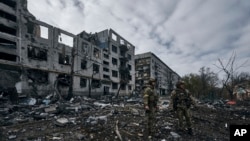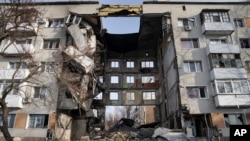"The long history of my family and the long history of my country is imprinted in every house of this small, sunny, warm and cozy city," says Ukrainian journalist Yelizaveta Honcharova.
On the first day of the full-scale invasion, she left Bakhmut for Kyiv, realizing that if Russians occupied the city, they would likely arrest her. Honcharova's family had lived in Bakhmut since the early 20th century.
"Russia uprooted us. We were pulled out like a tree from the ground and thrown away. Bakhmut was a fertile ground for generations to live there."
More than 300 years of history
Bakhmut is one of the oldest cities in eastern Ukraine. Historians still debate its origin.
According to some, Zaporizhian Cossacks founded it as a fortress in the Zaporizhzhia Sich in the 1680s-90s. Sich was a semi-autonomous polity and proto-state of Cossacks, ancestors of modern Ukrainians.
Others believe that Bakhmut was founded as a border fortress in 1571 by the Moscow authorities in the areas populated by Ukrainian ancestors.
"We don't have competitors here. Nearby Donetsk is only 100 years old," says Volodymyr Berezin, a local historian and civil activist. He left the region in mid-March 2022 for western Ukraine.
The city grew and developed through the extraction of salt and trade.
"In our area, salt came to the surface. Our Bakhmut River is salty; salt lakes are nearby. We have salt in the air, and below us is a colossal layer of salt," Berezin says.
Tsarina Catherine II of Russia ordered the destruction of Zaporizhzhyan Sich in 1775, and its territories were incorporated into the Russian Empire.
"The city was a big cultural, spiritual and trade center. We had merchants. We had two Roman Catholic churches. We had a large Jewish center and several synagogues. There was an Orthodox cathedral and a mosque," Berezin says.
In 1924-2016, the city was called Artemivsk in honor of Bolshevik Fedor Sergeev-Artem, a close friend of Josef Stalin's. Bakhmutians, like millions of Ukrainians, became the victims of Soviet repression.
"My two great-grandfathers were imprisoned. I lived near the prison, where they were most likely executed," says Honcharova.
A large Jewish community resided in the city. During WWII, Nazi forces occupied the town.
"Approximately 3,000 residents of Bakhmut were brought to the dolomite mines, mostly Jews but also Gypsies and Red Army soldiers, and walled up alive. We opened the tunnels when the Germans were driven out and saw this horror — how a mother died there with a baby in her arms," Berezin says.
In Bakhmut, there was also the winery, which produced sparkling wine, known throughout the former Soviet Union.
"Our sparkling wine was the best in the Soviet Union. For many is hard to pick a souvenir, but not for me. I take a bottle of sparkling wine and salt," says Berezin.
Not a typical Donetsk region town
Former Bakhmut residents who spoke to VOA emphasized how different Bakhmut was from other cities of the Donetsk region, which usually grew from working settlements around mines and metallurgical enterprises.
Sergiy Maslichenko is Kosovo's European Bank for Reconstruction and Development mission head. He spent his childhood in the 70-80s in Bakhmut.
"It had no heavy industry, metallurgical or chemical plants. It is a city of light industry. There were many bakeries, a sewing factory and well-developed trade. It had a machine-building, non-ferrous metals plant, and mining equipment-building plant," Maslichenko says.
The city was home to several institutions of higher education and research. Before 2022, the city preserved many old buildings and architectural monuments.
Maslichenko remembers the parks and sports grounds where he spent his childhood, and the music school, founded in 1903.
"Bakhmut was a musical city. It had a well-developed musical education and a large music school." The world-famous composer Sergei Prokofiev was born near Bakhmut in 1891.
Svitlana Kravchenko, a local activist, remembers how sunny this city was.
"Bakhmut is a very warm city because many buildings are made of red bricks, the terracotta color, produced in Bakhmut. The city is very sunny because Donetsk region is in the south."
Kravchenko stayed in Bakhmut until August 2022, when heavy fighting was under way. She currently lives in Dnipro.
Ukrainian Bakhmut
Like the rest of Ukraine, Bakhmut was subjected to systematic forced Russification as a part of the Russian Empire and the Soviet Union — a change in the ethnic composition of the population due to the arrival of workers from Russia, suppression of political and cultural Ukrainian life and restrictions on the use of the Ukrainian language. However, the city remained Ukrainian.
"My grandfather lived in Bakhmut and spoke Ukrainian. I have preserved my grandfather's letters to my grandmother. He confessed his love in the Ukrainian language, in calligraphic, beautiful handwriting and refined style," Kravchenko says.
After the declaration of the short-lived independent Ukrainian People's Republic in November 1917, the Ukrainian military raised a blue and yellow Ukrainian flag for the first time in the Donetsk region. At the referendum of 1991, the overwhelming majority of Bakhmut residents voted for Ukraine's independence.
However, in 2014, some in Bakhmut supported the Russian-backed separatist movement.
Kravchenko says that motivated her to start helping the Ukrainian military and to study and popularize local Ukrainian culture. They restored clothes worn in the Donetsk region based on old photos and took their collection on the road.
"I decided that this was my fight. We opened the Donetsk region to the Greater Ukraine," she says.
The models were ordinary people connected with the Ukrainian army.
"It was always the same when women were getting dressed. Everyone would say, 'I'm too fat or too thin, or my arms are too long or too short!' Then, when a woman puts on traditional clothes, everyone says, 'I feel like a queen. I feel my world and Ukraine are standing behind me,'" she says.
Does Bakhmut have a future?
Kravchenko is confident that her city will be restored, and she will return.
"I will kiss the soil covered with the blood of our best soldiers."
Maslichenko, who works for the organization that plans to take an active part in the reconstruction of the country, hopes to participate in it professionally and one day bring his children to the city where he grew up.
Berezin is also confident that the city will come back to life and offers ideas for its restoration. One of them is to invite the best artists to create an art center.
"Only artists can artistically recreate today's events. For some, this city has become the Garden of Gethsemane, a city of betrayal. And for many of our guys who died here, this is Golgotha."
Honcharova believes that Bakhmut will be restored, but it will be a completely different city. In some sense, she says, it fulfilled its mission.
"The city began as a fortress to protect the borders. So, Bakhmut fulfilled this karmic mission. It became a fortress."
In 2017, nearly 76,000 people lived in Bakhmut.






